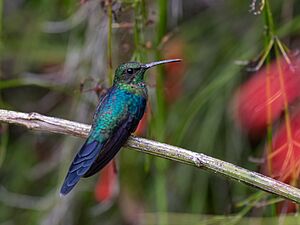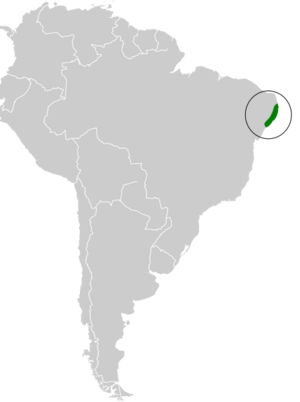Long-tailed woodnymph facts for kids
Quick facts for kids Long-tailed woodnymph |
|
|---|---|
 |
|
| Conservation status | |
| Scientific classification | |
| Genus: |
Thalurania
|
| Species: |
watertonii
|
 |
|
The long-tailed woodnymph (Thalurania watertonii) is a type of hummingbird. It belongs to the bird family called Trochilidae. This special bird lives in the wet forests of northeastern Brazil. You can find it in states like Pernambuco, Alagoas, Sergipe, and northern Bahia.
Even though it's found across a wide area, there aren't many of these birds. Their homes are shrinking because of deforestation and habitat loss. Scientists believe there are only about 1,000 to 2,500 long-tailed woodnymphs left. Their numbers are still going down.
Contents
What Does It Look Like?
Long-tailed woodnymphs look different depending on if they are male or female. This is called being sexually dimorphic.
Males are heavier and have bigger wings and tails. They are about 11.8 to 13 centimeters (4.6 to 5.1 inches) long. Their long tail can be up to 6 centimeters (2.4 inches) by itself!
Females are a bit smaller, measuring about 10 to 11 centimeters (3.9 to 4.3 inches) long. Their tails are shorter, around 3.6 centimeters (1.4 inches). Both males and females weigh about 3.7 to 5.2 grams.
Male and Female Colors
Male long-tailed woodnymphs are very colorful and shiny. Their feathers can look blue, green, and purple.
- Their head and neck are a bronze-green color.
- Their back is a shiny violet-blue.
- Their belly is a bright grass-green.
- Their sides are violet-blue.
- Their long, deeply-forked tail is blue.
Female birds have much duller colors. This helps them blend in and stay hidden. Their tail is shorter and has a white tip with a blue band. Young birds look similar to adult females.
Where Do They Live?
This hummingbird lives only in certain parts of Brazil. It is found in the states of Pernambuco, Alagoas, and Sergipe. There are also old reports from northern Bahia, but no recent sightings.
The long-tailed woodnymph prefers coastal lowland areas. This includes coastal rainforests, plantations, and parks. They live from sea-level up to about 550 meters (1,800 feet) high. They usually look for food at low to medium heights, often at the edges of plants.
Life and Habits
The long-tailed woodnymph eats nectar from flowers. They get nectar from vines, cacti, epiphytes (plants that grow on other plants), trees, and bushes. Sometimes, they also catch small invertebrates (like insects) while flying.
Male woodnymphs set up feeding areas. They will bravely defend these areas from other hummingbirds, even from other long-tailed woodnymphs.
Reproduction and Nesting
Long-tailed woodnymphs usually have their babies between November and February. The female bird builds a special nest. It is shaped like a cup and is made from tiny roots and moss. She uses spider's web to tie it all together very tightly.
The nest is usually attached to a horizontal branch of a small tree or shrub. It is often hidden by leaves hanging over it. The nest is typically about 1.5 to 2.5 meters (5 to 8 feet) above the ground. The female usually lays two eggs. She sits on the eggs for about 14 to 15 days to keep them warm until they hatch.
Why They Need Our Help
The long-tailed woodnymph is listed as an Endangered species by the IUCN Red List. This means they are at a very high risk of becoming extinct.
Their population is shrinking because their home, the lowland forests in northeastern Brazil, is being destroyed. The area where they live is now less than 500 square kilometers (193 square miles). The remaining groups of birds are very spread out and small. Scientists estimate that the total population is less than 2,500 birds. Each small group has fewer than 250 birds. Protecting their forest homes is very important to help these beautiful hummingbirds survive.


